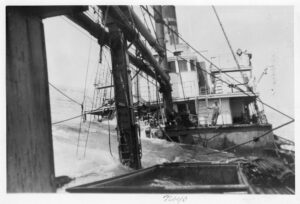
These tidbits of shipping history on the Mendocino Coast started from an investigation into why the Union Lumber Company’s California Western Railroad Navigation subsidiary had the word “navigation” in the title. Well, in 1905 all finished lumber products were sent to the San Francisco Bay Area by sea. It would be a decade before the railroad from Fort Bragg to Willits was finished and a new rail connection to the outside world established. Because Fort Bragg’s Union Lumber Company operated a railroad on the wharf, it could charge “wharfage” fees to move other companies’ products over it. Wharfs equal navigation. Right? “Navigation” stayed in the subsidiary company’s title until 1948.
You need ships to go with the navigation, so another subsidiary company was invented — the National Steamship Company, with eight lumber schooners. They included the National City, Brunswick, Coquille River, Arctic and three different Noyos. The Arctic, built in 1901 in Bay City, Oregon, lasted 20 years. The Coquille River, constructed at Prospect, Oregon, hauled lumber and passengers almost 30 years. A product of North Bend, Oregon, shipyards, the Brunswick ran 28 years. The National City, built in San Francisco, served twelve years before being sold to Peru in 1918.
The first ships were wooden schooners, dependent on sail, and a trip San Francisco could take a few days or two weeks, depending on the wind. Steam schooners of iron came later and could make the trip in fifteen hours, carrying lumber, freight and up to 40 passengers.
I think the National Steamship Company got lazy naming their last three ships: they were the Noyo, the Noyo #2 and the Noyo #3. Often purchased used, the first Noyo had been owned by a Greenwood lumberman and was called the L.E. White from 1887-1898. Then it became the J.S. Kimball until 1901, then the Noyo. It was wrecked at Point Arena in 1914. The Noyo #2 had been called the Aroline, then the Admiral Goodrich and in 1939 it, too, wrecked at Point Arena. The Noyo #3, previously the Griffdu, managed not to wreck at Point Arena and was sold to Thailand in 1940. It transported south the last boards ever milled at Mendocino in 1938.
The first Noyo arrived on the Coast after a trip to Alaska in August of 1898 with its flag at half-mast. Captain H. Edgett had died of Brights’ Disease on board and was buried in Unalaska. Of the 30 passengers the Noyo carried, 20 were returning from the Alaska Gold Rush at Dawson. It was noted they had found but a small amount of gold after having gone north in the spring and failed to find their fortunes.
Another local vessel whose name was used more than once was the Sea Foam. The first one was a wooden steam schooner built in Aberdeen, Washington, in 1904 and it ran aground in Point Arena in 1931. The second Sea Foam, built in 1905, carried 70 passengers and freight and was making two round trips a week to San Francisco in 1916.
The nickname of the fleet of coastal lumber schooners was the “Scandinavian Navy” as many captains were Swedish, Norwegian, Finnish and Danish. All the captains had nicknames. “Hog” Aleck once had a deckload of swine, wrecked, and wanted the Coast Guard to save his pigs. Captain Gudmond “Midnight” Olsen believed in being on time as he carried U.S. Mail and would cross the dangerous bar in to Humboldt Bay at the midnight hour to be on time to San Francisco. Captain “Hoodlum” Bob Walvig was handy with his fists, keeping his sailors in line. “Port Wine” John Ellefsen didn’t like whiskey and served his crew port wine. Captain “Saturday Night” Jack Bostrom made sure his ship was tied up at the wharf Saturday night when there was a country dance at a nearby schoolhouse.
A sad note was found in a listing of steamers that used to visit the Coast and were lost without a trace. The Galatea, built here by Thomas Petersen, left San Francisco in a gale and was never seen again. The Rosa Sparks was built in Whitesboro in 1882 and later retrofit for codfishing. She took off for the Sea of Okhotsk and was never found again. The Lizzie Wylde was built in Point Arena in 1865 and lost three years later.
The demise of steam schooners came as highway transportation of lumber improved. Steam schooners were recycled and converted. Some became garbage scows, hauling Oakland and San Francisco garbage out beyond the Farallon Islands to be dumped in the ocean. They became cattle carriers, barges and fuel oil tankers. They were fish reduction facilities, salvaged or, when other ships were being scrapped, they were loaded with useful items. They became gunboats and ammunition carriers in South America. One was lucky enough to become a gambling barge parked offshore in Southern California.
For more information on shipping, visit the Kelley House Research Office weekday afternoons. The archives and library contain endless resources about our shipping past. You can also visit kelleyhousemuseum.org and click “search online collections.”